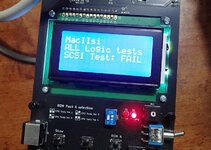David Cook
Well-known member
Over the years, I have accumulated a handful of Macintosh IIsi computers with partially working SCSI that end up corrupting the hard disk images. No other computers have suffered the same fate, and I have plenty of IIsi computers that work perfectly. So, I am fascinated to determine what exactly makes the IIsi so vulnerable.
Before I hook up my oscilloscope and logic probe, I need to have a disk image that is read-only (to prevent corruption) and contains the various utilities I'll be using. The obvious method is to burn a CD and then read that CD back as an iso image. Then, place that iso image on my MacSD or ZuluSCSI. I feel like there must be a simpler method.
What is the easiest way to make a read-only volume on MacSD or ZuluSCSI?
Bonus: Any tips on diagnosing SCSI issues? (I am aware of termination and the fact that term power is missing on the IIsi)
- David
Before I hook up my oscilloscope and logic probe, I need to have a disk image that is read-only (to prevent corruption) and contains the various utilities I'll be using. The obvious method is to burn a CD and then read that CD back as an iso image. Then, place that iso image on my MacSD or ZuluSCSI. I feel like there must be a simpler method.
What is the easiest way to make a read-only volume on MacSD or ZuluSCSI?
Bonus: Any tips on diagnosing SCSI issues? (I am aware of termination and the fact that term power is missing on the IIsi)
- David

